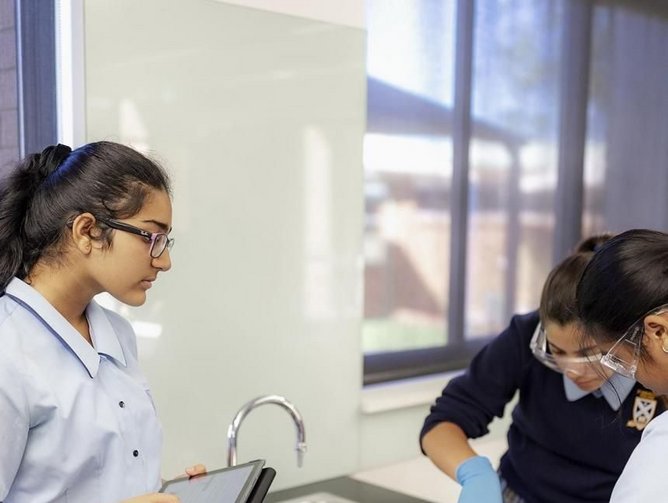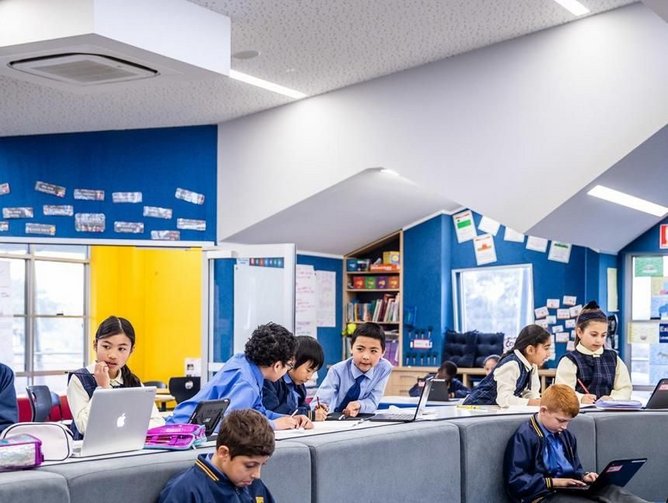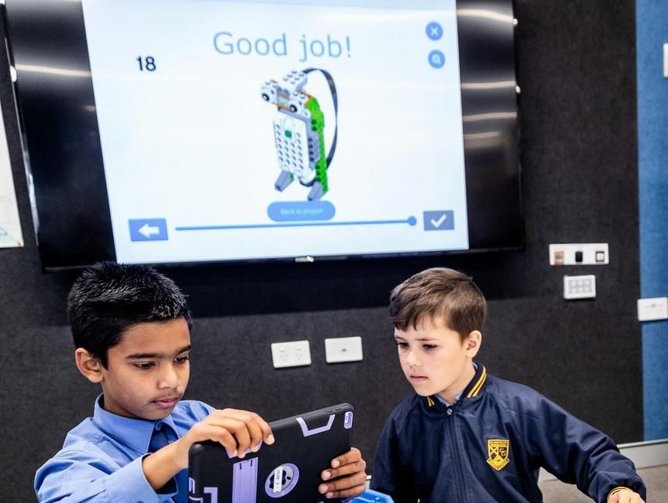Catholic Education Diocese of Parramatta uses data analysis and machine learning to transform the student experience
Catholic Education Diocese of Parramatta (CEDP) oversees 80 Catholic schools in Western Sydney, with around 43,000 students and 5,000 staff. CEDP’s Executive Director is Greg Whitby AM KSG, who alongside the Director of Data Intelligence, Raju Varanasi, has overseen a large-scale digital transformation to the benefit of its schools. With so many stakeholders, efficiency is vital, as Varanasi explains: “Digital transformation has two main focus points for us. The first is transparency and the ease of releasing information and intelligence to teachers, students and staff. The second is operational excellence: saving time and costs.”
A new model
To change the model in the ways CEDP has, it was necessary to change the mindset throughout the organisation. “Greg knew that digital transformation came with a bit of risk, but a change of mindset had to happen,” says Varanasi. “I work with the principals to build their trust about why transformation has to happen. Every time I present to them, I try to better understand why something might be working while another thing isn’t.” Heading a team of six directors, Whitby sees his role as further enhancing learning and teaching in schools. “My job is strategic positioning. I have to make sure that our system is fit for purpose in five years time. The question I constantly ask myself is: ‘Are we going to be relevant, around and in the market in five years’ time?’” Ensuring schools maintain a culture capable of thriving inside the constantly evolving digital realm is critical.
Another significant change has been in the way learning and teaching is delivered. Whitby identifies the rapidly changing marketplace for schooling, with the increasing popularity of homeschooling and micro-credentialing, as examples of why schooling must better meet the demands of today’s learners in today’s world. “Going to school, getting your leaving certificate, then going to university to get a BA and then an MA – for many, those days are numbered. Yet schools still operate as if they are a sausage machine feeding people through.” A contemporary model of schooling puts the learner at the centre of schooling. “We've embarked on a process of transformation in our schools,” Whitby explains. “We believe that contemporary schooling, the way it's currently delivered in an industrial model, is no longer fit for purpose in today's world. We've got to build diversity into the system because we believe that diversity is the norm in learning. Each person is different and they each have different needs.”
Technology transformation
To achieve such a change in the model, CEDP has introduced a broad range of technological solutions. Foundational is the provision and analysis of data, allowing informed decision-making and identifying potential problem areas. “We’ve opened up the data sets, which were largely in spreadsheets and had never seen the light of day in terms of analysis or insights or intelligence,” says Varanasi. “Our data team compiles data sets on several aspects of schooling – literacy, numeracy, intervention support, student attendance and so on. We then blend it with various other sources and create our data sources, keeping them up-to-date and scheduling them for refresh.” Using solutions such as Tableau and Alteryx, data has been made accessible to, and understandable for, principals and teachers. “They used to take 30 minutes to look at attendance data, on a weekly or even a daily basis; now they take less than a minute.” CEDP takes a six lens approach to analytics, encompassing Student Performance, Resourcing and Regulatory, Community and Culture, Family and Religion, Teacher Development and School Performance, which it has found to be a useful framework. With its improved content management systems and enterprise service desk, the organisation has also managed to significantly reduce the time it takes to search for data and report problems. Such innovations are beneficial to both business process improvement and the overall company strategy. “Our footprint is almost 90% in the cloud, and many of our investments have now turned from capital expenditure to operational,” says Varanasi.
CEDP has been an early adopter of machine learning technology, allowing it to better utilise the data it collects. Bringing it to bear on student retention, the organisation wanted to discover the connections between students who left its system between primary and secondary school. “We have introduced machine learning at a system level, in consultation with our directors and leaders,” says Varanasi. “We are already seeing gains from it.” Aside from the business and cost imperatives, the technology also finds a use in helping to identify students who require additional support. “Machine learning is predictive and proactive. Three years back, all I saw was the post-mortem analysis of results. Our intervention program for literacy and numeracy allows us, if the cutoff is the 90th percentile, to actually predict those between 87 and 90 so that schools can take action to lift their results.”
With such complex technological solutions, CEDP needed the expertise of specialists in their respective fields. “Schools in the old model were hermetically sealed,” says Whitby. “You went inside the gate in the morning, you came out in the afternoon, and nobody else came inside or went outside. You can't operate like that now. It's about building connections and working with people who can add value to your business processes.” CEDP has partnered with a number of technology companies. With IT provider CompNow, CEDP has partnered to provide integrated procurement and lifecycle management solutions, and best in breed choice to the bring-your-own-device program across Chromebooks, MacBooks and iPads. Telstra helps ensure that CEDP’s networking infrastructure meets the demand from its 80 schools and a load of between 30 and 35 thousand devices whilst remaining economical. “Cisco has been a long standing partner in our technology journey,” says Varanasi. “Cisco's equipment provides the ‘connect’ part of our connected learning strategies.” To ensure ongoing connectivity in such a large system, CEDP relies on cloud managed service provider Secure Agility to identify and remedy any issues when they arise. “One particular challenge that we have tackled for CEDP is visibility of network performance and efficiency, by building dashboards that assist in reducing time to resolve issues and ensuring learning experiences are optimised” says Secure Agility Director of Technology Charlie Tannous. CEDP’s enterprise operations are powered by TechOne solutions: “their Finance, Content, and Asset Management solutions are bringing productivity and consistency across all schools in our system.” In data analysis, the company employs the services of data specialists outside the organisation, as Varanasi explains: “When I have a complex problem, I use the senior data analysts from MIP Australia.” CEDP also uses FACES, a student management system developed by Cinglevue, in all of its schools. “It's a robust enterprise system that has enabled us to embark on the analytics journey with great confidence in the student data we have captured.” By collaborating with its partners, CEDP can ensure the smooth operation of its many high-tech schools.
The student experience
The most important beneficiaries of CEDP’s digital transformation are the students, and Varanasi was keen to extend his data collection efforts towards the wellbeing of students. “We know our student experience is improving because, for example, we perform an annual survey called ‘Tell Them From Me’ where we listen to all 43,000 of our students. The social side of learning and wellbeing has become a much bigger focus for us as a result of the data obtained from ‘Tell Them From Me’. While digital transformation needs to be shown in student performance or school performance, it must also be about student experience and helping optimise the learning experience for each child.”
CEDP has found the effect on its students’ learning to be equally transformative. This has stemmed in part from the reduced burden on teachers and principals, allowing them to move away from administrative tasks to spend time on more important matters. “If a principal spends less time on administration, or invoicing, supplier and repair issues, they can concentrate on educational leadership,” says Varanasi. With its strong record of implementing technology that frames and streamlines school processes, it is fitting that CEDP also uses technology in the classroom to directly improve learning. Our students and teachers are able to interact through systems such as Google Classroom,” says Varanasi. “Technology isn’t a substitute for the face-to-face teaching, it enhances it. It provides more opportunities for teachers and students to have richer day-to-day interactions. That's how technology is improving teaching and learning.”
This notion of transformation also extends to the physical realm, with CEDP exploring innovative locations and architecture, including asking Secure Agility to lay the foundation for IOT (internet of things) opportunities that will enable truly dynamic and responsive classroom environments. “Our new schools, including the last five schools that we have commissioned, are truly 21st century,” says Varanasi. “We speak to experts in learning environments and spaces, because you can't just change the curriculum without changes the learning spaces. Learning environments must allow for collaboration. They should mirror today’s workplaces: we want our students to work in a space that promotes collaboration and learning.” Whitby concurs, detailing two of the organisation’s upcoming projects. “We're building our latest school in a community precinct, because that's where the community is. Why build a school on a hill, put a fence around it and use it for just 40 weeks of the year? We will also build a school in the precinct surrounding Sydney’s second airport as part of a major science and technology park. We will partner with other education, business and industry providers. It's an opportunity to be part of a community that will change the very nature of schooling.”
Given the rapidly changing nature of today’s world, CEDP sees its transformation agenda as an ongoing process. “Our goals for the future are to drive change in the ways learning is done, the ways learning spaces are organised and the ways that teachers interact with students through technology,” says Varanasi. In doing so, not only will schools thrive in a business sense, but students will develop the skills and capabilities necessary for the modern world. “The old model’s broken,” says Whitby. “Let's be honest about it and build the future. All we're doing is short-changing tomorrow's generation if we continue teaching them in the same way. Times have changed, and technologies like data and machine learning in the school system are here to stay.”





